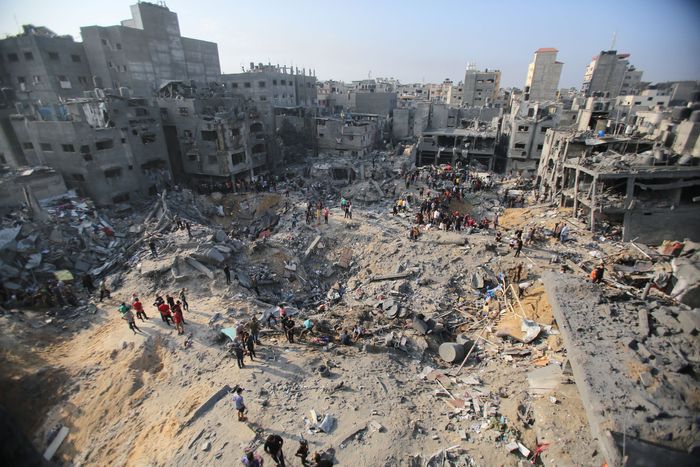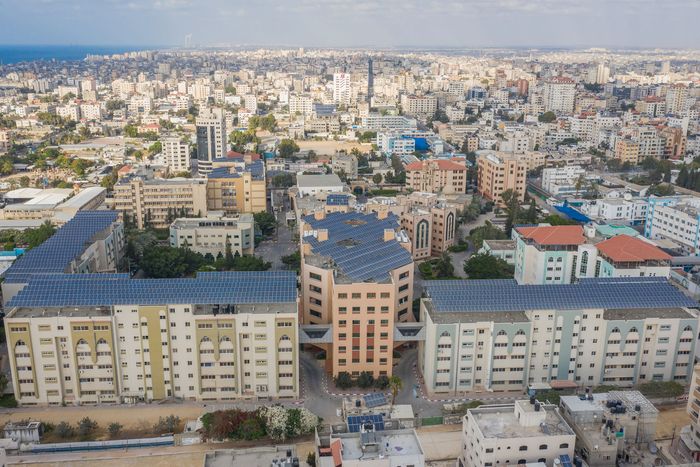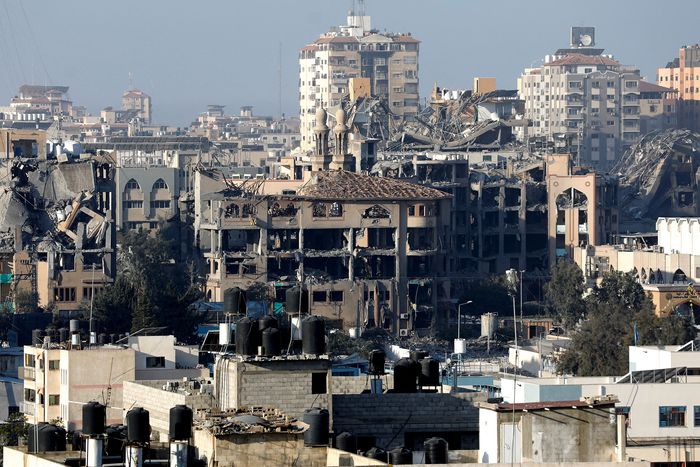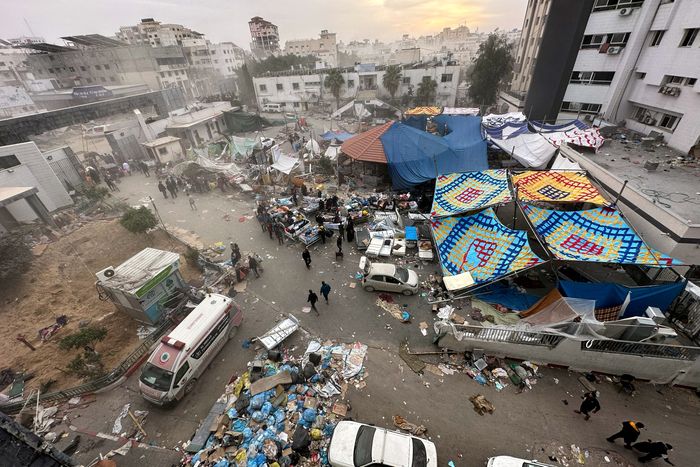
Those of us lucky enough to have had our elders with us grew up listening to their recollections of Palestine. But in all of their stories, a rupture occurs at roughly the same point in time. My grandfather told me he never knew whether he passed his high-school exams because his school suddenly ceased to exist. My grandmother was forced to leave her childhood home in the city of Tiberias and could never go back because it was seized by the Israeli state and later occupied by Israeli families. Our elders were not just driven out of their homes by Zionist paramilitaries in 1948, but more than 500 villages were destroyed, their water wells and crops ruined, their markets, their schools, their hospitals bombed. These were their stories of the Nakba, or “the Catastrophe” in Arabic, a term Palestinians use to mark the events of 1948. For 750,000 Palestinians, that rupture was permanent; they were never allowed to return.
What we seem to be witnessing today is a potential return to that time. By the middle of December, Israel had dropped more than 29,000 tons of explosives on the Gaza Strip, and, with the exception of a six-day cease-fire in November, barraged the area day and night. At least 85 percent of the territory’s 2.3 million residents, including survivors of the Nakba, have been displaced. As an architectural historian, I am particularly anguished by what is happening to the built fabric of Gaza — its apartment buildings, houses, schools, hospitals, gardens, water lines. Many of us spend our waking hours dreading the possibility that cities such as Beit Hanoun, Jabalia, and Gaza City — a city that is 4,000 years old, that we Palestinians look up to — might not exist after this wave of destruction comes to a halt. They would follow the fate of Jaffa, Haifa, Lydda, Ramle, and other major maritime centers that have ceased to exist as Palestinian cities since 1948.
Gaza, before this assault, had already been deemed uninhabitable. It was entering its 17th year of an economic blockade, had withstood waves of episodic Israeli air raids that had flattened many buildings, and lacked adequate infrastructure such as water and electricity — all manmade conditions that amount to an Israeli policy of “de-development,” resulting in an economy almost completely dependent on international aid. In 2015, the U.N. warned that Gaza would become “uninhabitable” in five years and declared it “unlivable” in 2018. Yet life in Gaza persisted.
Now, its built environment is turning into rubble. At least 70 percent of Gaza’s housing stock is damaged or uninhabitable, which amounts to more than 300,000 homes. Satellite and drone analysis from late December revealed that up to 175,000 buildings may have been damaged or leveled by Israel’s bombs. Entire neighborhoods are being ground to dust, not just from the air, but increasingly by planned demolitions set by Israeli troops on the ground in Gaza. Researchers at CUNY and the University of Oregon who analyze satellite imagery of war-torn areas have said that the damage in Gaza appears to be more widespread than that in many recent conflicts, including in Syria and Ukraine.
Some of the most densely populated areas in the Strip are the eight refugee camps run by the U.N. On October 31, Israel hit the largest of them, Jabalia, with a barrage of 2,000-pound bombs. Jabalia, established by the U.N. in 1948, would be better described as a city rather than a camp, as a dense settlement filled with low-rise buildings separated by narrow alleys, home to at least 116,011 registered refugees. After the bombing, it looks like it was struck by a comet. Nothing is recognizable: streets, sidewalks, walls, roofs, water tanks, solar panels, windows, doors, laundry lines, or trees. Hundreds were injured or killed, and who knows how many more trapped underneath collapsed buildings. Since then, Israel struck Jabalia again and also bombed at least five other refugee camps.
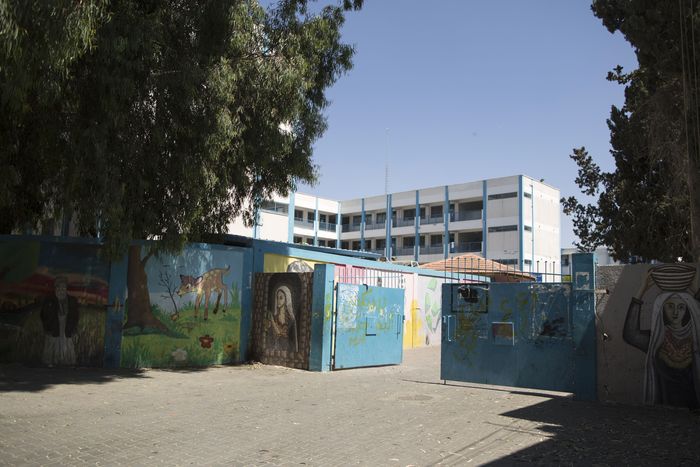
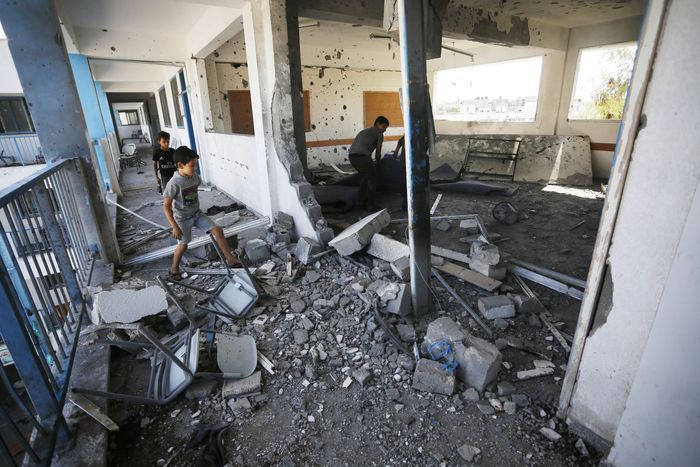
Within the refugee camps, the schools run by the U.N. Relief and Works Agency are meant to be safe havens — they are easily recognizable from the air with their distinctive façades of blue railings and columns against white walls. Or so was the assumption for 4,000 people who found shelter at the UNRWA school in the Maghazi refugee camp in Gaza. On October 17, the school was hit by an Israeli air strike, killing six people who were sheltering there. Dozens more were injured, and the building endured “severe structural damage.” A couple of weeks later, Israel bombed the Al-Fakhoura U.N. school in Jabalia. At least 50 people were killed, and scenes from inside the school show “dead bodies everywhere.”
On October 20, Israel bombed the Saint Porphyrius Greek Orthodox Church, killing 16 people who sought shelter within its walls. The church, one of the most significant Christian Palestinian landmarks and Gaza’s oldest active church, likely dates back to the fifth century and is named after the bishop of Gaza at the time, Saint Porphyrius. For the Palestinian Christian community, it is a significant social space that has provided services and relief for generations. The next day, amid the rubble of its own broken walls, the church hosted a mass funeral in the courtyard. It is just one of many religious structures damaged by the strikes; Gaza’s Great Omari Mosque, one of the most important Islamic landmarks in Palestine, was also destroyed, its minaret barely standing. U.N. monitors have reported that at least 110 mosques and three historic churches have been damaged by the strikes, and satellite analysis has also found that some, in the north, have been completely leveled.
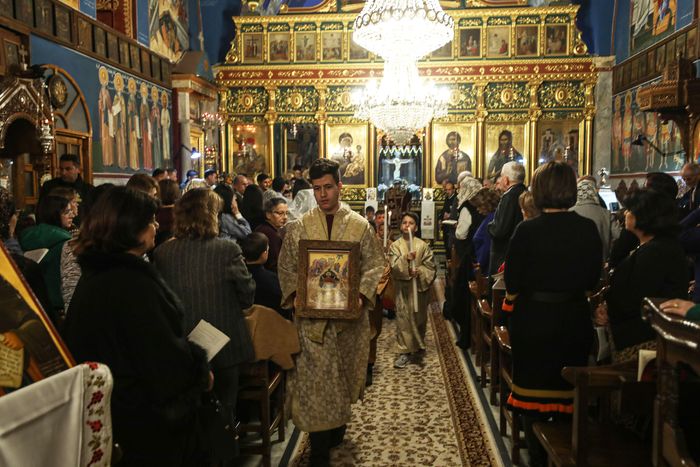
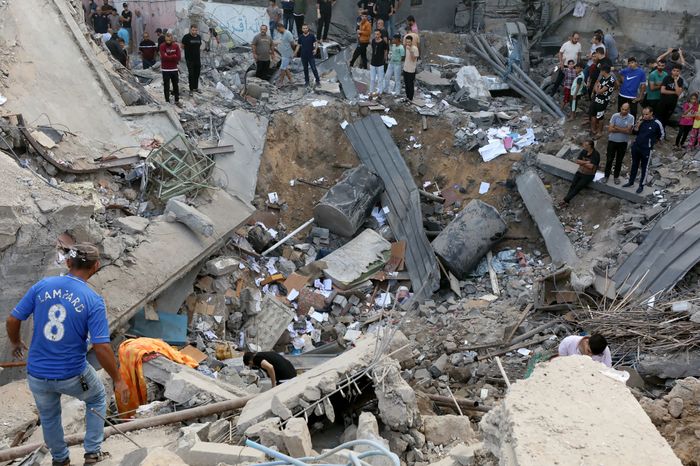
On October 11, Israel bombed the Islamic University of Gaza, the first institution of higher learning established in Gaza in 1978. It holds one of the largest student bodies in the Strip, and its campus of 11 buildings has been targeted by Israel in the past. This time, the campus’s central buildings were bombed so heavily that many of its buildings were reduced to rubble. Not a tree, sidewalk, sign, or car can be seen on the grounds surrounding the building. The ground is covered in a dust of pulverized concrete, dotted with books and whatever else was ejected out of the buildings from the blast. Students will not be returning to class anytime soon, and, like my grandfather Jamal, those close to graduation may never receive their diplomas.
But perhaps the most consequential and devastating target of Israel’s bombardment has been Gaza’s hospitals. These function not only as medical centers, but also as places where thousands of Gazans, some critically injured, have sought shelter. Now, Gaza’s hospital capacity has been “decimated,” with nearly all of its 36 hospitals no longer functioning. Whatever facilities remain open lack energy or water and continue to be bombed and raided by the Israeli army. The photographs and videos leaking out of Al-Ahli hospital, Al-Shifa hospital, and the Indonesian hospital show wounded bodies on the floor of the hallways, doctors being forced to operate without proper equipment or anesthetics, and unusable, destroyed sections of what were once fully functioning medical departments. We are witnessing hospitals effectively transformed into prisons and tombs, where death is an inevitability.
But why target a refugee camp, or a church, or a hospital? Israel has justified its relentless bombing as a military strategy to accomplish its goal of “eliminating Hamas.” By its logic, every structure (and every person) becomes a legitimate target, and we can see this at play in Israel’s attacks on an ambulance, a hospital, a mosque, or a line of civilians walking south toward the so-called safe zone.
The history of architecture and of cities is often told in terms of what gets built. But reading the rubble in Gaza reveals much more. Israel’s relentless flattening of buildings and infrastructure in Gaza has rendered it not only uninhabitable, but also unrecognizable. This severs people’s connections to the land and clears it for resettlement. This is not a hypothetical argument. In recent weeks, Israeli officials, including its minister of intelligence, have called for the removal of all Palestinians from the Gaza Strip, framing ethnic cleansing as an “opportunity.” According to an Israeli news report, Prime Minister Benjamin Netanyahu had also assigned his minister of strategic affairs the task of “thinning” Gaza’s population “to a minimum” and persuading neighboring Arab countries to accept refugees. And most recently, 12 ministers from Netanyahu’s party and two cabinet members attended an ultranationalist conference in Jerusalem, where participants called for the Israeli resettlement of Gaza. The images from 1948 and the images from the present conflict converse with one another.
Some have referred to what is happening in Gaza as an act of domicide, or the systematic destruction of homes. But Israel’s attacks have gone much further; by destroying critical infrastructure like greenhouses and hospitals, along with religious edifices, schools, and archaeological sites, it seems to be embarking on a campaign of urbicide, or a premeditated assault on the city itself and all that it represents: a sense of collective identity, community, and culture. This isn’t a new argument when it comes to Palestine, but there is a renewed sense of urgency to name it when the urban fabric of Gaza, which has its residents to rebuild after previous conflicts, is being destroyed wholesale.
The U.N. convention on genocide does not mention domicide or urbicide by name, but it does contain an article that defines it as “deliberately inflicting on the group conditions of life calculated to bring about its physical destruction in whole or in part.” When Palestinians’ only options are deciding between being crushed by the weight of their buildings falling on them, being shot while attempting to flee, or dying in an overcrowded camp from disease, starvation, and the lack of running water, they are effectively facing the elimination of life in every space. Israel has made Palestinian life in the region a near impossibility.
In the early weeks of bombing, those Gazans who had survived returned to their neighborhoods to look for traces of their homes: a charred wall, a broken gate, a piece of furniture sticking out from between the mounds of rubble. It reminds me of my grandfather, who was never allowed to return to Sajra, his village, but was able to recognize it in later images because he could spot the Ein (the water well) and the trees that were still standing. Now, it seems, no well and no tree are allowed to remain in Gaza.




